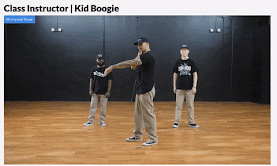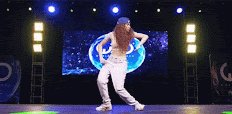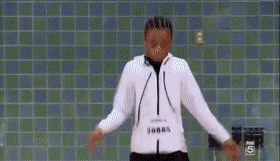Hello
charlie.
I think it’s
about time I make a second one of these. This time, we’ll look at another one
of the old styles and with their long standing presence, are filled with
sub-styles.
Today we’ll
look at
Popping
So… what’s popping?

<-- here is a pop
Here what makes a good pop dancer is control
of one’s body, being able to twitch fast, strongly, dissociate at will every
single muscle and contract exactly what you want.
Before
showing anymore of popping we need to talk about another style that is often
combined with it. These 2 styles are so often combined that in multiple
competition they are considered as one.
And this style is…
*drumroll*Just like
in the name you make waves with your body, this style is kind of the opposite
of popping, focusing on motions of your general body flowing constantly the
energy throughout your body.
However, what is common between the two is their focus on the control of oneself, people that do waving need to be able to dissociate every articulation to make their waves flow, what body part connects to what body part to accentuate your movement, and also the control of the intensity or the variation in the intensity of the wave.
Now let’s look at what makes popping great. (at
least in my book)
With these
gifs it’s difficult to find where it is beautiful or at least it doesn’t seem
all that good. But first you need to consider how difficult it is to make it
look good, because just twitching on beat might seem easy, and it is, but it’s
difficult to make it look great, and that demands a very precise control.
With this
one more than any other style I advise you to watch battles or choreography
because you will see how much corresponding to the music is part of this dance.
That’s what we call musicality, how much a dancer can ‘play’ with a music, by
being on beat, becoming one with the music; which is particularly important
here. Another element that makes popwave be great in its own way is the
creativity.
 You have
this very strict and limited tool box and so you need to think: “okay, how can
I convulse on beat and make it different from the others and be interesting”.
Find your own way of popping by looking at the different . Whereas, if we
compare it to break, the creativity can come from anywhere, you can make up
your own move, have your own way to do the moves, and also assemble preexisting
moves into something of your own.
You have
this very strict and limited tool box and so you need to think: “okay, how can
I convulse on beat and make it different from the others and be interesting”.
Find your own way of popping by looking at the different . Whereas, if we
compare it to break, the creativity can come from anywhere, you can make up
your own move, have your own way to do the moves, and also assemble preexisting
moves into something of your own.
Plus, if we
add the fact that most battles are improvised on the music, we can understand
how great the dancers are.
And mind
you most choreography have chosen their music and most battle are improvised,
they don’t know the music that will pass in advance.
These two
styles are dances as old as hip hop and so we can dance them on basically anything.
Plus, technically we enter the debate that any dance can be done on anything.
But as a rule of thumb, they are danced on music that are very technical with
multiple complexities. Musics that are made for complex musicality, musics that
are irregular and difficult to adjusts yourself onto it. Another type of music
on which popping is mostly done is slow beats. In those it is easier to change
from pose to pose as well as to be able to develop a wave, mostly able for
newcomers.
Another name might correspond better here, because, in the appearance of raves in the 1990s popping got heavily mixed with waving to the point where today they’re inseparable. In turn, now we also call this mixture is the “Popwave” for popping and wave or “Liquid” for “Electric Liquid” which was the name rave enthusiast gave, showing how strong its popularization was, because now it’s one of the terms unused to refer to it.
However,
popping is clearly a style that is malleable and can be done on almost
anything. And I think that’s why it stuck, its capacity to be able to blend
anywhere make it still in a lot of favor from a number of dancers today,
everyone knows at least a little bit of popping and waving.
Anyway,
here are some songs that would be perfect musics for popping and waving, and
also here are some examples of battles. Mostly what we would call electric
liquid for the more dubstep related music but you can also, for some feel the
synthesizers from the 80s rather heavily forothers.
https://www.youtube.com/watch?v=HT9T6DzaNHk
https://www.youtube.com/watch?v=dqYuAWhGFqc
https://www.youtube.com/watch?v=IIQjbqdlP0U
https://www.youtube.com/watch?v=Q-gcfQhR_9c
All in all
check out the artist tuxedo he does a lot of nice songs that aren’t just beats
: https://www.youtube.com/channel/UCkKZ6hhB4dyHh7wGQ_fKYdw
But now
let’s look at subgenres or substyles in popping.
Popping has
often paired with multiple other styles that we will talks about later, most
notably one that rules before him, Locking. Mostly with the ‘pop and lock’
move, move that gave the name to both of these different styles, we can also
see it in the ‘skoobydoo’.
But in the
substyles, we can understand it as a fragmentation of the different elements
that compose popping.
Because, yes,
I lied to you [outrageous right]. Because popping isn’t just the pop. We could
summarize them in 3 main elements that each have their own most dedicated
substyles.
Strutting is often associated to stretched out limbs with strong ticks, it’s the purest substyle of popping, not touched by any other type of move. And such a restriction requires creativity to not make new move, but to find compelling poses.
First the robot, is centered on freezing parts and either moving body-parts separate and only move certain other parts.
So here is someone that isolates like a robot and puts wave into them (also called boogaloo)
But then there are the ones where a number of people join in to make
other shapes was popularized by the French crew “Geometrie Variable” I
recommend you their videos. Like this one https://www.youtube.com/watch?v=z_ECUtjO1ks
Anyway that
will be the end to this presentation of popwave (popping and wave... depends
on your point of view). One last crumb that I want to give out, is that these
two styles are really done on a lot of different music and so you can find that
sometimes with things that aren’t AT ALL hiphop.
And just for some food for thoughts here are some example of performances if you have some time in your day:
https://www.youtube.com/watch?v=cU-J533NMC0









No comments:
Post a Comment